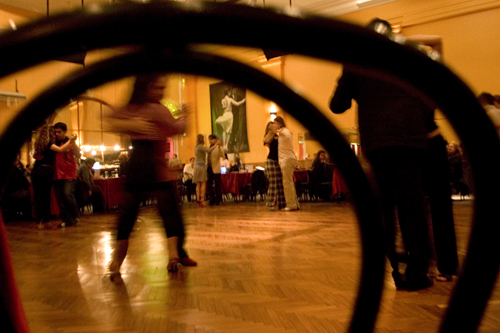
TANGO LESSONS WELLINGTON
Phone: 022 024 5311
Email: dance@tangolessons.co.nz
TANGO GLOSSARY
Foundation Tango concepts: axis, steps, embrace.
Body position and basic steps
Effective lead and elegant following depends on proper position of feet, hips, and torso of the leader and the follower.

On and off axis
Position-related concepts of Argentine tango are axis and off-axis positions. Body position in which legs are approximately perpendicular to the floor is called 'axis' and there are two axis positions associated with one of two legs. Off-axis positions are called apile (apilado, carpa, volcada) or colgada. The center of balance moves outside one's body in case of the off-axis moves.

Embrace and styles
Argentine tango dancing consists of a variety of styles that developed in different regions and eras and in response to the crowding of the venue and even the fashions in clothing. It is danced in an embrace that can vary from very open, in which man and woman connect at arms length, to very closed, in which the connection is chest-to-chest, or anywhere in between. Styles of dance are not predefined by the embrace itself and many figures of tango salon style are danced in an open embrace, it is also possible to dance tango nuevo in close V-shape embrace.
The milonguero (apilado) style is an exception; it is a close embrace without a V-shape and an emphasis on maintaining this embrace throughout the dance – this embrace predetermines the range of possible movements and their shape.
Dance embraces

Practice embraces
Embrace hold used during tango lessons or practice, these are to focus on learning various parts of the steps, the torso and chest location/rotation.
Walking systems
Walking in a cross system is defined as when the leader steps with his right leg forward and the woman steps with her right leg back or when the leader steps with his left leg forward and the woman with her left leg back.
Walking in a parallel system is defined as when the leader steps with his left leg forward and the woman steps with her right leg back or when the leader steps with his right leg forward and the woman with her left leg back.
The leader can change his weight from one foot to another while the follower's weight remains unchanged.
The changing of feet is named contrapaso, or "contra-step". This change can be made off or on the normal beat.

Some Argentine tango teachers teach complex figures but break them down into simpler parts. Subsequently they teach students how to improvise their own figures. Beginner classes may include caminada – combination of caminar (walk), cross, and ochos. The beginning part of a figure, its starting-point, is called salida (exit or beginning – as in "beginning of a journey"). The end part of a figure is called resolución. Combination of the salida, a walk, the cross of the lady and the resolución is called basic step (paso basico, la base, salida simple).
Thus, an Argentine tango figure is the pattern of salida, combination of elements, and resolución. This makes for flexible, ever-changing patterns. It gives leader an exceptional opportunity to improvise, and in part makes the Argentine tango unique in the dance world.
Salidas

Technique and embellishments
Women's technique and embellishments
As in many dances most spectators observe mostly woman in dance – her elegance, grace, music interpretation as well as technique. Even though these are highly individual attributes there are some general notions of what makes woman sensual and graceful when dancing tango. Such skills include leg projection and weight transfer, stability in movements, elegance in leg placement and leg extension, pivoting, embellishments, as well as expression of emotions.

Man's technique
Both partners can contribute to tango improvisations with adornments (sp. adornos, decoration) known also as decorations (sp. decoration). Adornments do not have to be led or marked. Several embellishments are: aguja, amague, boleo, caricia, cuatro, enroscar, golpecito, lustrada, rulo.

Variants and shape
It is interesting to note that tango elements come in a variety of shapes determined by, for example, elasticity or flexion of the execution of movement. Such variants gives a figure a more modern or traditional look, it can be an expression of woman's creativity, or simple adjustment to how crowded is the floor.
Many tango steps are often borrowed from tango shows, but modified for the tight spaces and flow of other dancers around the floor. Many of these steps are part of tango nuevo. The shape of the steps can vary – for example, how the woman's body is curved during the step may change according to her interpretation of the music or the moment. There are several instructional videos illustrating sequences of tango nuevo such as colgadas and volcadas with elements of traditional tango.

Figures
Cross and ocho
Large group of classic and elegant tango figures is related to two basic steps: forward cross step and backward cross step. Their combinations form cruce (cross), ochos (figure eight), as well as giros (turns).

Circular movements
Circular movements are an inherent part of tango and have special importance in tango vals.

Foot play
Steps related to foot play steps spice up the walk and the dance. These are ways for leaders and followers to challenge and tease their partners and make dance more playful. There are different shapes to these moves and their look depends on how crowded the dance floor is and/or the woman's interpretation of the lead.

Sacada and entrada

Gancho and enganche

Boleos

Colgada and volcada

Everything else

Ending figures
The most typical endings of tango are simple positions, for example "sandwich" or "tango close". However, in the popular culture tango endings are often associated with more dramatic figures such as listed below.

Notes and references from Wikipedia
^ Castle, Vernon and Castle, Irene (1911). Modern Dancing. New York: Harper and Brothers. ^ Clendenen, F. Leslie (1914). Dance Mad: Or, the Dances of the Day. St. Louis: Arcade. ^ Baim, Jo (2007). Tango: Creation of a Cultural Icon. Bloomington and Indianapolis: Indiana University Press. ISBN 978-0-253-34885-2. ^ Castro, Luis and Mendoza, Claudia (2007). Argentinian tango, the dance in depth. Berkeley, CA: General Printing. ^ Tejastango.com ^ Paez, Luiza (2005). Follower's technique by Luiza Paes. Pulpo's Tango. (head, hands, arms, legs, feet, natural step, pivot, ochos, turn, cross, boleo, sacada, barrida, contact, enganche, adorments) ^ a b Balmaceda, Julio and Rosa, Corina (2005). DVD, Tango secrets and basis, Vol. 1. Julio Balmaceda y Corina de la Rosa Prodduciones. (el eje, la intención, el caminar, la contraposición, el abrazo, basico cuadrado y cruzado, primer secuencia caminada, ocho adelante, ocho atrás, combinación del ocho adelante y atrás, medio giro derecha e izquirda) ^ a b c Rosas, Gustavo and Natoli, Gisela (2007). Curso basico de colgadas y volcadas, Tango, Vol.1, Fusion tango nuevo y tradicional. Gus Producciones. DVD, in Spanish with English subtitles (colgada en línea, colgada circular, colgada en apertura, colgada en apertura con cruce atrás, arrastre con colgada, colgada en cruce atrás, colgada en ocho atrás, colgada en suspensión, ochos atrás bloqueados en volcada, volcada con dibujo círcular de la pierna libre, ocho cortado, secuencias de colgadas & volcadas). ^ a b Rosas, Gustavo and Natoli, Gisela (2008). Curso basico de colgadas y volcadas, Tango, Vol.2, Fusion tango nuevo y tradicional. Gus Producciones. DVD, in Spanish with English subtitles (sanguchito colgado, sanguchito colgado y gancho, colgada en apertura, barrida, colgada y gancho, americana, colgada y gancho, boleo, colgada y sacada, colgada en apertura con cruce, volcada y gancho, volcada líneal y circular). ^ a b Rosas, Gustavo and Natoli, Gisela (2010). Tango "Milonguero Nuevo", Vol. 1., DVD, Tango tradicional con elementos nuevos. Gus Prodduciones. (step of Gisela, the stop and pasada, soltada in turn to the right, stop and colgada positions, soltada and back sacada, blockade soltada, linear boleo, linear boleo with enganche, volcadas and colgadas, ela paso básico, salida simple, salida cruzada (salida of 1940's), ocho atrás, ocho adelante), ^ a b c Paez, Luiza and Esbrez, Norberto ("Pulpo"). Pulpo's tango en La Patriótica. (trap sacadas, wrap sacadas, drags, basic ganchos, 3 ganchos, 4 ganchos, gancho boleo, carried gancho, enganches) ^ Gavito, Carlos and Duran, Marcela (2000). Un tal Gavito (Someone called Gavito), Classes de tango, DVD and tape, Vol. 1. MusicMedia Productions. (salida in two steps, salida or basic step, cadence with woman's sweep, walking on the edge of the roof, the corkscrew, walk with sacada and boleo (role of the knee), walking on both sides of the woman, cadence with turn, "fan" with barrida sacada and boleo, enrosque with walk). ^ a b Gavito, Carlos and Duran, Marcela (2000). Un tal Gavito (Someone called Gavito), Classes de tango, DVD and tape, Vol. 2. MusicMedia Productions. (tent salida, barrida with backwards sandwich, barrida with forward turn, boleo with traspie, back sacada, forward cross, natural cross, enrosque, sacada-sacada, escape with boleos). ^ a b Gavito, Carlos and Duran, Marcela (2000). Un tal Gavito (Someone called Gavito), Classes de tango, DVD and tape, Vol. 3. MusicMedia Productions. (waiting, beauty and simplicity, veiled glances, subtle expressions, apíle o carpa, syncopated salida, sandwiches in turn, barrida from position 2, double cross, wheel with sandwich, induced barrida). ^ a b c Balmaceda, Julio and Rosa, Corina (2005). Tango giros, Vol. 2. DVD. Julio Balmaceda y Corina de la Rosa Prodduciones. (foundation of the circular movement, structure of the twist, double time in turn, showing medio tempo to the woman, twists with entradas (difference between sacada and entrada), twist with entrada to the right, twist with entrada to the left, twist with entrada both ways, exercises for lapiz, turn to the left with lapiz, exercises with the lapiz: woman, turn with entradas and lapiz to the right, turn with enrosques (twists), twist with entradas and sacadas, twist with entradas and sacada behind the man, La Bordona) ^ Tejastango.com ^ Saba, Benzecry (2010). New glossary of tango dance, key tango Argentino dance terms, prefaces by Juan Carlos Copes and Carlos Gavito, epilogue Miguel Angel Zotto. Abrazos. ISBN 978-987-24481-8-9. ^ Saba, Gustawo Benzecry (2007). Embracing tango, techniques and metaphors between tango and life. Abrazos. ISBN 978-3-939871-03-3. ^ Denniston, C. (2007). The meaning of tango; the story of the Argentinian dance. Portico. ISBN 978-1-906032-16-6. ^ Turner, David (2004). A passion for tango. Dingley Press. ISBN 0-9547083-1-8. ^ Paz, Alberto and Hart, Valorie. Gotta tango. Human Kinetics. ISBN 978-0-7360-5630-4. ^ Gift, Virginia (2008). Tango: A history of obsession. ISBN 1-4392-1462-X. includes chapter "New Tango" by Gustavo Naveira ^ Dancevision.com